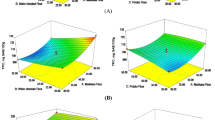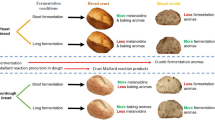Abstract
The study is aimed at developing a new cereal-based product, with increased nutritional quality, using quinoa flour. The effect of the use of transglutaminase (TGase) and proteolytic enzymes on the microstructure, properties and in vitro digestion of gluten-free bakery products based on quinoa flour was evaluated. Microstructural results evaluated by means of Scanning Electron Microscopy showed that the quinoa starch granules are rather small (0.4–2 µm) and the presence of TGase induced significantly changes in dough and baked samples microstructures. The overall acceptability of the breads was improved by TGase addition. The results achieved showed that these enzymes have different effects on the bread characteristics and may improve properties of formulations, setting the basis for the development of baked quinoa products.







Similar content being viewed by others
References
Leonard MM, Sapone A, Catassi C, Fasano A (2017) Celiac disease and nonceliac gluten sensitivity: a review. JAMA 318(7):647–656
Capriles VD, Areas J (2014) Novel approaches in gluten-free breadmaking: interface between food science, nutrition, and health. Comp Rev Food Sci Food Saf 13(5):871–890
Aponte M, Boscaino F, Sorrentino A, Coppola R, Masi P, Romano A (2013) Volatile compounds and bacterial community dynamics of chestnut flour based sourdoughs. Food Chem 141(3):2394–2404
Deora NS, Deswal A, Mishra HN (2015) Functionality of alternative protein in gluten-free product development. Food Sci Technol Int 21(5):364–379
Martínez MM, Gomez M (2017) Rheological and microstructural evolution of the most common gluten-free flours and starches during bread fermentation and baking. J Food Eng 197:78–86
Moroni AV, Dal Bello F, Arendt EK (2009) Sourdough in gluten-free bread-making: an ancient technology to solve a novel issue? Food Microbiol 26:676–684
Elgeti D, Nordlohne SD, Föste M, Besl M, Linden MH, Heinz V, Jekle M, Becker T (2014) Volume and texture improvement of gluten-free bread using quinoa white flour. J Cereal Sci 59:41–47
Turkut GM, Cakmak H, Kumcuoglu S, Tavman S (2016) Effect of quinoa flour on gluten-free bread batter rheology and bread quality. J Cereal Sci 69:174–181
Rizzello CG, Lorusso A, Montemurro M, Gobbetti M (2016) Use of sourdough made with quinoa (Chenopodium quinoa) flour and autochthonous selected lactic acid bacteria for enhancing the nutritional, textural and sensory features of white bread. Food Microbiol 56:1–13
Wang S, Zhu F (2016) Formulation and quality attributes of quinoa food products. Food Bioprocess Technol 91:49–68
Pellegrini M, Gonzales RL, Ricci A, Fontecha J, Fernández-López J,. Pérez-Álvarez JA, Viuda-Martos M (2018) Chemical, fatty acid, polyphenolic profile, techno-functional and antioxidant properties of flours obtained from quinoa (Chenopodium quinoa Willd). seeds. Ind Crops Prod 111:38–46
Stikic R, Glamoclija DJ, Demın M, Vucelıc-Radovıc B, Jovanovıc Z, Jacobsen SE, Mılovanovıc M (2012) Agronomical and nutritional evaluation of quinoa seeds (Chenopodium quinoa Willd.) as an ingredient in bread formulation. J Cereal Sci 55:132–138
Navruz-Varli S, Sanlier N (2016) Nutritional and health benefits of quinoa (Chenopodium quinoa Willd.). J Cereal Sci 69:371–376
FAOSTAT (2013) What is quinoa? Distribution and production. Santiago, Chile: International Year of Quinoa Secretariat Food and Agriculture Organization of the United Nations Regional Office for Latin America and the Caribbean. http://www.fao.org/quinoa-2013/what-is-quinoa/distribution-and-production/en/. Accessed 24 Jul 2014
Medina W, Skurtys O, Aguilera JM (2010) Study on image analysis application for identification quinoa seeds (Chenopodium quinoa Willd) geographical provenance. LWT Food Sci Technol 43:238–246
Nowak V, Du J, Charrondière UR (2016) Assessment of the nutritional composition of quinoa (Chenopodium quinoa Willd). Food Chem 193:47–54
Alvarez-Jubete L, Arendt EK, Gallagher E (2010) Nutritive value of pseudocereals and their increasing use as functional gluten-free ingredients. Trends Food Sci Tech 21(2):106–113
Ando H, Chen YC, Tang H, Shimizu M, Watanabe K, Mitsunaga T (2002) Food components in fractions of quinoa seed. Food Sci Technol Res 8(1):80–84
Haros M, Rosell CM, Benedito C (2002) Effect of different carbohydrases on fresh bread texture and bread staling. Eur Food Res Technol 215(5):425–430
Hemalatha MS, Prasada Rao UJS, Leelavathi K, Salimath PV (2010) Influence of amylases and xylanase on chemical, sensory, amylograph properties and microstructure of chapatti. LWT Food Sci Technol 43:1394–1402
Barbosa-Ríos JA, Castill Jardòn J, Guadarrama-Lezama AY, Alvarez-Ramirez J, Meraz M, Carrillo-Navas H (2018) Effect of new generation enzymes addition on the physical, viscoelastic and textural properties of traditional Mexican sweet bread. J Cereal Sci 79:160–167
Gray JA, Bemiller JN (2003) Bread staling: molecular basis and control. Comp Rev Food Sci Food Safety 2(1):1–21
Renzetti S, Bello FD, Arendt EK (2008) Microstructure, fundamental rheology and baking characteristics of batters and breads from different gluten-free flours treated with a microbial transglutaminase. J Cereal Sci 48:33–45
Steffolani ME, Ribotta PD, Perez GT, Leon AE (2010) Effect of glucose oxidase, transglutaminase, and pentosanase on wheat proteins: relationship with dough properties and bread-making quality. J Cereal Sci 51:366–373
Scarnato L, Montanari C, Serrazanetti DI, Aloisi I, Balestra F, Del Duca S, Lanciotti R (2017) New bread formulation with improved rheological properties and longer shelf-life by the combined use of transglutaminase and sourdough. LWT Food Sci Technol 81:101–110
Monogioudi E, Faccio G, Lille M, Poutanen K, Buchert J, Mattinen ML (2011) Effect of enzymatic cross-linking of β-casein on proteolysis by pepsin. Food Hydrocoll 25:71–81
Romano A, Giosafatto V, Di Pierro P, Romano R, Masi P, Mariniello L (2016) Impact of transglutaminase treatment on properties and in vitro digestibility of white bean (Phaseolus vulgaris L.) flour. Food Res Int 88:239–246
Renzetti S, Arendt EK (2009) Effect of protease treatment on the baking quality of brown rice bread: from textural and rheological properties to biochemistry and microstructure. J Cereal Sci 50:22–28
Iglesias-Puig E, Monedero V, Haros M (2015) Bread with whole quinoa flour and bifidobacterial phytases increases dietary mineral intake and bioavailability. LWT Food Sci Technol 60:71–77
AACC (2000) Approved methods of the AACC, 10th edn. American Association of Cereal Chemists, St. Paul (Methods 44–19, 46–30)
Romano A, Masi P, Pucci E, Oliviero V, Ferranti P (2017) Encapsulated proanthocyanidins as novel ingredients. Chem Eng Trans 57:1885–1890. https://doi.org/10.3303/CET1757315
Stone H, Sidel JL (1998) Quantitative descriptive analysis: developments, applications and the future. Food Technol 52:48–52
Romano A, Blaiotta G, Di Cerbo A, Coppola R, Masi P, Aponte M (2014) Spray-dried chestnut extract containing Lactobacillus rhamnosus cells as novel ingredient for a probiotic chestnut mousse. J Appl Microbiol 116(6):1632–1641
Alencar NMM, Carvalho de Morais E, Steel CJ, Bolini HMA (2017) Sensory characterisation of gluten-free bread. Int J Food Sci Technol 52:872–879
Atwell WA, Patrick BM, Johnson LA, Glass RW (1983) Characterization of quinoa starch. Cereal Chem 60:9–11
Li G, Zhu F (2018) Quinoa starch: structure, properties, and applications. Carbohydr Polym 181:851–861
Hsieh HM, Swanson BG, Lumpkin TA (1999) Starch gelatinization and microstructure of azuki an granules prepared from whole, abraded, or ground beans. LWT Food Sci Technol 32:469–480
Young CT, Pattee HE, Schadel WE, Sanders TH (2004) Microstructure of peanut (Arachis Hypogaea L. Cv. ‘NC 7’) cotyledons during development. LWT Food Sci Technol 37:439–445
Romano A, Giosafatto CVL, Masi P, Mariniello L (2015) Impact of dehulling on the physico-chemical properties and in vitro protein digestion of common beans (Phaseolus vulgaris L.). Food Funct 6:1345–1351
Lorenz K (1990) Quinoa (Chenopodium quinoa) starch–physico-chemical properties and functional characteristics. Starch/Stärke 42:81–86
Ruales J, Nair BM (1994) Properties of starch and dietary fibre in raw and processed quinoa (Chenopodium quinoa, Willd) seeds. Plant Foods Hum Nutr 45:223–246
Srichuwong S, Curti D, Austin S, King R, Lamothe L, Gloria-Hernandez H (2017) Physicochemical properties and starch digestibility of whole grain sorghums, millet, quinoa and amaranth flours, as affected by starch and non-starch constituents. Food Chem 233:1–10
Jekle M, Becker T (2011) Dough microstructure: novel analysis by quantification using confocal laser scanning microscopy. Food Res Int 44:984–991
Renzetti S, Dal Bello F, Arendt EK (2008) Microstructure, fundamental rheology and baking characteristics of batters and breads from different gluten-free flours treated with a microbial transglutaminase. J Cereal Sci 48:33–45
Bonet A, Rosell CM, Caballero PA, Gòmez M, Pérez-Munuera I, Luch MA (2006) Glucose oxidase effect on dough rheology and bread quality: a study from macroscopic to molecular level. Food Chem 99:408–415
Abugoch JLI (2009) Quinoa (Chenopodium quinoa Willd.): composition, chemistry, nutritional, and functional properties. Adv Food Nutr Res 58:1–31
Capriotti AL, Cavaliere C, Piovesana S, Stampachiacchiere S, Ventura S, Zenezini Chiozzi R, Laganà A (2015) Characterization of quinoa seed proteome combining different protein precipitation techniques: Improvement of knowledge of nonmodel plant proteomics. J Sep Sci 38(6):1017–1025
Onyango C, Mutungi C, Unbehend G, Lindhauer MG (2010) Rheological and baking characteristics of batter and bread prepared from pregelatinized cassava starch and sorghum and modified using microbial transglutaminase. J Food Eng 97:465–470
Chlopika J, Pasko P, Gorinstein S, Jedryas A, Zagrodzki P (2012) Total phenolic and total flavonoid content, antioxidant activity and sensory evaluation of pseudocereals breads. LWT Food Sci Technol 46:548–555
Acknowledgements
Thanks to Mr. Gaetano Coppola—Department of Agricultural Sciences, University of Naples Federico II for technical help.
Author information
Authors and Affiliations
Corresponding author
Ethics declarations
Conflict of interest
The authors have declared no conflict of interest.
Compliance with ethics requirements
All procedures performed in studies involving human participants were in accordance with the ethical standards of the institutional and/or national research committee and with the 1964 Helsinki declaration and its later amendments or comparable ethical standards.
Rights and permissions
About this article
Cite this article
Romano, A., Masi, P., Bracciale, A. et al. Effect of added enzymes and quinoa flour on dough characteristics and sensory quality of a gluten-free bakery product. Eur Food Res Technol 244, 1595–1604 (2018). https://doi.org/10.1007/s00217-018-3072-x
Received:
Revised:
Accepted:
Published:
Issue Date:
DOI: https://doi.org/10.1007/s00217-018-3072-x




